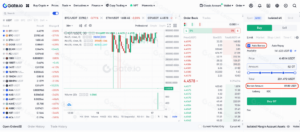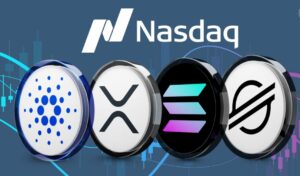
The advent of cryptocurrency trading has fundamentally transformed the landscape of finance, presenting individuals and institutions with unique and unprecedented opportunities to generate profits. Among the various trading techniques that traders can employ, leverage trading emerges as a particularly noteworthy method due to its potential to significantly enhance returns on investment. However, it is essential to recognize that this powerful tool does come with its own set of risks that traders must carefully consider. If you find yourself intrigued by the mechanics of leverage trading or if you’re looking to sharpen your short-term trading strategies on popular platforms such as Gate.io, then this comprehensive guide is tailored for you. By understanding how leverage works and developing sound trading strategies, you can position yourself to take advantage of the opportunities that arise while also managing the risks involved.
Understanding Crypto Leverage Trading
Understanding Crypto Leverage Trading is crucial for anyone looking to navigate the volatile and fast-paced world of cryptocurrency markets. By using leverage, traders can amplify their potential profits, but this also comes with the risk of magnifying losses. As cryptocurrencies continue to evolve, gaining a solid grasp of how leverage works and its impact on trading strategies is essential for both beginners and experienced traders alike.

What is Leverage Trading?
Crypto leverage trading, also known as margin trading, is a financial strategy that allows traders to borrow capital from an exchange or broker to increase the size of their trading positions. In simple terms, it enables traders to trade with more money than they have in their accounts, aiming to amplify potential profits and take advantage of market movements more effectively. However, while leveraging can enhance earnings, it also comes with significant risks. By increasing their market exposure, traders face the possibility of losses that may exceed their initial investment if the market moves against their position. This high-risk, high-reward nature of crypto leverage trading requires careful planning and strong risk management strategies, such as setting stop-loss orders, diversifying portfolios, and closely monitoring market conditions. Given the volatility of financial markets, traders must approach crypto leverage trading with caution and a solid understanding of the associated risks. While it presents substantial profit opportunities, success in crypto leverage trading demands discipline, strategic execution, and a well-informed approach.
How Does Leverage Trading Work?
Crypto leverage trading is a financial strategy that allows traders to control a position larger than their initial capital by borrowing funds. This approach helps amplify potential returns, but it also increases the risk of losses. The level of leverage available depends on the trading platform and the specific asset being traded. Typically, leverage ratios range from 2x, where traders control twice their investment, to as high as 100x, allowing them to manage a position 100 times larger than their original capital.
When a trader opens a leveraged position, they enter a borrowing agreement with the exchange or brokerage. This means they are using borrowed funds to increase their market exposure. For example, with 10x leverage, a trader investing $1,000 can control a position worth $10,000. If the market moves in their favor, the profits are based on the total position size, leading to significantly higher gains than trading with only the initial capital.
However, leverage trading carries substantial risks. While the potential for increased profits is attractive, losses can also be magnified. A small price drop in the market can result in large financial losses, sometimes exceeding the trader’s initial investment. If the market moves too far against their position, they risk liquidation, meaning the exchange will automatically close their trade to prevent further losses.
Due to these risks, traders should always use risk management strategies, such as stop-loss orders, position sizing, and careful market analysis. While leverage trading can be a powerful tool for increasing profits, it requires discipline and a solid understanding of market dynamics to avoid significant losses.
Why Use Leverage Trading in Crypto?
Crypto leverage trading presents a variety of benefits for individuals engaged in cryptocurrency trading, making it an appealing strategy for many investors.

- Amplified Profits: One of the primary advantages of crypto leverage trading is the ability to control larger positions than what one’s initial capital would typically allow. This means that even with a modest investment, traders can significantly amplify their potential profits. For instance, if a trader uses 10x leverage, a small price movement can lead to substantial gains, thus maximizing returns on investment.
- Diversification: Leverage enables traders to diversify their portfolios by allocating funds across various cryptocurrencies or other assets without requiring a large amount of capital upfront. This diversification can help mitigate risks, as the performance of different assets may not be correlated, allowing traders to balance out potential losses in one area with gains in another.
- Short Selling: Another significant advantage of crypto leverage trading is the ability to engage in short selling. This strategy allows traders to profit from declining markets by borrowing assets and selling them to buy them back at a lower price. In the highly volatile world of cryptocurrencies, where prices can fluctuate dramatically, this capability can be particularly beneficial for traders looking to capitalize on downturns.
- Access to More Opportunities: Leverage trading also provides access to high-value assets that might otherwise be unattainable for individual traders. By using borrowed funds, traders can enter positions in expensive cryptocurrencies or other financial instruments, thereby expanding their trading horizons and increasing their potential for profit.
Despite these advantages, it is essential to approach crypto leverage trading with a great deal of caution. The same factors that can lead to amplified profits can also result in significant losses. As such, effective risk management strategies should be prioritized to protect one’s investments. Traders must be aware of the inherent risks associated with leveraged positions and should consider setting stop-loss orders or limiting the amount of leverage they use to safeguard against unexpected market movements. Overall, while crypto leverage trading can enhance opportunities for profit, it requires careful planning and disciplined execution to navigate the complexities and risks involved.
Getting Started with Leverage Trading on Gate.io
Gate.io is recognized as one of the top cryptocurrency exchanges in the market, primarily due to its intuitive user interface, sophisticated trading tools, and strong emphasis on security measures. If you’re interested in engaging in crypto leverage trading on Gate.io, here’s a comprehensive step-by-step guide to help you navigate the process effectively:

- Create an Account: Sign up on Gate.io and complete the verification process to unlock full trading features.
- Deposit Funds: Transfer cryptocurrency or fiat into your Gate.io wallet. Ensure you have enough funds to cover your initial margin and potential losses.
- Navigate to Margin Trading: Go to the “Margin Trading” section on Gate.io and select your desired trading pair (e.g., BTC/USDT).
- Choose Your Leverage Level: Gate.io offers leverage options ranging from 2x to 100x. Beginners should start with lower leverage (e.g., 2x-5x) to minimize risk.
- Open a Position: Decide whether to go long (buy) or short (sell) based on your market analysis. Enter your position size and confirm the trade.
- Monitor and Manage Your Trade: Use tools like stop-loss and take-profit orders to manage your risk and lock in profits.
By following these steps, you can embark on your crypto leverage trading journey on Gate.io with greater confidence and understanding. Always remember that trading cryptocurrencies involves significant risks, and it’s essential to educate yourself continuously and practice sound risk management strategies.
Short-Term Trading Strategies for Leverage Trading
Short-term trading refers to the practice of maintaining financial positions for a brief period, which can range from just a few minutes to several days. This trading style is particularly appealing because it allows traders to capitalize on small price movements in the market. When traders employ leverage—essentially borrowing funds to increase their potential returns—the opportunity for substantial profits becomes even greater. However, it is important to note that while leveraging can amplify gains, it can also magnify losses, making risk management crucial.
For those interested in exploring short-term trading, various strategies have proven effective over time. These strategies can be implemented on platforms like Gate.io, which is known for its diverse range of cryptocurrency trading options. By utilizing these methods, traders can enhance their chances of success in the fast-paced world of short-term trading. Whether you are a novice or an experienced trader, understanding and applying these strategies can help you navigate the complexities of the market more effectively.

Scalping
Scalping and momentum trading are two popular short-term trading strategies used by traders to capitalize on price movements in the market. Crypto leverage trading in scalping involves executing multiple trades throughout the day to profit from small price fluctuations. Positions are typically held for only a few seconds to a couple of minutes, focusing on highly liquid trading pairs that allow quick entry and exit without significantly impacting prices. To make informed trading decisions, scalpers often rely on technical indicators such as Moving Averages and the Relative Strength Index (RSI). Moving Averages help identify trends by smoothing out price data, while the RSI indicates whether an asset is overbought or oversold, signaling potential reversal points. Risk management is crucial in scalping, and traders use tight stop-loss orders to limit losses and protect their capital. Success in scalping requires a deep understanding of market dynamics, quick decision-making, and strict discipline.
Momentum Trading
Momentum trading focuses on assets experiencing strong price trends, whether upward or downward. Traders employing this strategy look for assets with high trading volumes and significant price movements, as these indicate strong market interest and potential for continued momentum. Key technical indicators such as Bollinger Bands and the Moving Average Convergence Divergence (MACD) are commonly used to confirm momentum. Bollinger Bands help assess volatility and detect overbought or oversold conditions, while the MACD provides insights into trend strength and direction. However, momentum traders must remain vigilant, as market trends can shift suddenly. A decline in trading volume, price reversals, or weakening trend signals can indicate that momentum is fading, prompting traders to exit positions to secure profits and minimize potential losses. By staying alert and using the right tools, traders can maximize opportunities in fast-moving markets.
Breakout Trading
Breakout trading is a strategy used by traders to take advantage of significant price movements when the market surpasses established support or resistance levels. To apply this approach effectively, traders must first analyze historical price data to identify these key levels, as they indicate where the price has previously struggled to move beyond. Once these critical levels are determined, traders should watch for a confirmed breakout, which occurs when the price breaches the support or resistance level with increased trading volume—an essential signal that the breakout is genuine rather than a temporary fluctuation. To manage risk, setting stop-loss orders just below the breakout level is recommended, as this helps protect against potential losses if the price reverses direction. By combining thorough analysis, timely execution, and smart risk management, traders can enhance their chances of success in breakout trading.
Arbitrage Trading
Arbitrage is a crypto leverage trading strategy that takes advantage of the variations in prices for the same asset when it is listed on multiple exchanges. This practice requires traders to keep a close eye on the price differences that may arise between platforms, such as Gate.io and its competitors. By identifying these discrepancies, traders can execute buy and sell orders swiftly to profit from the gap in pricing. To effectively engage in arbitrage, one must not only be vigilant about monitoring these price fluctuations but also act quickly, as these opportunities can vanish in an instant due to market movements. Additionally, it is crucial to consider transaction fees associated with executing trades on different exchanges. These costs can significantly impact overall profitability, so they must be factored into any calculations before proceeding with an arbitrage trade. By carefully analyzing both the potential gains from the price difference and the costs incurred through transactions, traders can determine whether a particular arbitrage opportunity is worth pursuing.
Risk Management in Leverage Trading
Engaging in crypto leverage trading can offer significant rewards and opportunities for profit, but it is essential to approach this strategy with a strong emphasis on risk management. One of the most effective ways to mitigate potential losses is by setting stop-loss orders. These orders automatically sell your assets when they reach a predetermined price, thereby helping you limit your losses in volatile market conditions.
In addition to implementing stop-loss orders, it is vital to avoid the temptation of over-leveraging. Over-leveraging occurs when traders borrow excessively against their capital, which can lead to devastating financial consequences if the market moves unfavorably. Maintaining a balanced approach to leverage ensures that you do not expose yourself to unnecessary risks.

Another important aspect of managing risk in crypto leverage trading is diversification. By spreading your investments across various assets or sectors, you can reduce the impact of any single poor-performing investment on your overall portfolio. This strategy helps to cushion your financial standing during market fluctuations.
Staying informed about market news and trends is also crucial for successful crypto leverage trading. Being aware of economic indicators, geopolitical events, and other factors that may influence market movements allows you to make more informed decisions and adjust your strategies accordingly.
Furthermore, utilizing risk-reward ratios can be an effective way to evaluate potential trades and ensure long-term profitability. A favorable risk-reward ratio means that the potential reward from a trade outweighs the risk involved, providing a clearer picture of whether a trade is worth pursuing.
Lastly, it is imperative to adhere to the principle of only investing what you can afford to lose. This mindset helps to alleviate stress and anxiety associated with trading, allowing you to make decisions based on logic rather than emotion. By following these guidelines, you can navigate the complexities of crypto leverage trading while minimizing risks and maximizing your chances of success.
Conclusion
Crypto leverage trading can be a powerful strategy for maximizing profit margins, but it requires a deep understanding of the market and disciplined risk management. By borrowing funds to increase position sizes, traders can amplify both gains and losses, making it crucial to approach leverage trading with caution and a well-planned strategy. Platforms like Gate.io offer various tools and resources to help traders develop effective short-term strategies in the highly volatile crypto market. While this volatility presents opportunities, it also carries significant risks, making it essential for traders to refine their skills and navigate market fluctuations with confidence.























